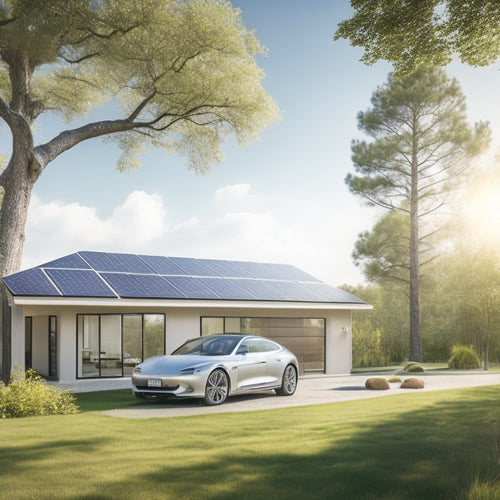
What Extends Autonomous Vehicle Battery Life?
Share
By optimizing autonomous vehicle design, advanced battery management systems, efficient electric motor technology, and smart charging strategies, you can increase battery life by up to 20%, extending the driving range and reducing energy consumption. This can be achieved through aerodynamic design, weight reduction, and advanced battery monitoring, as well as efficient motor controllers and smart charging schedules. By implementing these strategies, you'll not only increase battery life but also reduce energy waste and peak demand. As you explore these factors further, you'll uncover more opportunities to maximize your autonomous vehicle's battery life and performance.
Key Takeaways
• Advanced battery management systems, including cell balancing and thermal monitoring, extend autonomous vehicle battery life.
• Optimized electric motor technology, including in-wheel motors and advanced cooling systems, reduces energy consumption and heat generation.
• Smart charging strategies, such as Time of Use pricing and Vehicle to Grid technology, reduce battery degradation and increase lifespan.
• Streamlined vehicle design, including aerodynamic shapes and weight reduction, minimizes energy consumption and reduces battery load.
• Efficient computing and smart sensor management protocols minimize energy waste and reduce battery drain.
Optimizing Autonomous Vehicle Design
By streamlining the autonomous vehicle's design, you can greatly reduce its energy consumption, paving the way for extended battery life and enhanced overall performance. One pivotal aspect of design optimization is aerodynamics. By incorporating aerodynamic shapes, you can minimize air resistance, reducing the energy required to propel the vehicle forward. This, in turn, decreases the load on the battery, leading to increased efficiency and longer battery life.
Another critical factor is weight reduction. The lighter the vehicle, the less energy it requires to move, resulting in reduced energy consumption. You can achieve weight reduction through the strategic use of lightweight materials, such as carbon fiber or aluminum, in the vehicle's frame and body. Additionally, optimizing the vehicle's shape and size can also contribute to weight reduction.
Advanced Battery Management Systems
Implementing advanced battery management systems in your autonomous vehicle enables you to monitor and control battery performance in real-time, allowing for precise adjustments to optimize energy efficiency and extend battery life. This is essential, as it guarantees your vehicle operates within a safe and efficient operating range.
| Feature | Function | Benefit |
|---|---|---|
| Cell Balancing | Monitors and adjusts individual cell voltage | Prevents overcharging, reduces wear, and increases lifespan |
| Thermal Monitoring | Tracks battery temperature in real-time | Enables proactive cooling, reduces degradation, and prevents thermal runaway |
| State of Charge (SOC) Estimation | Accurately estimates battery capacity | Optimizes charging, reduces wear, and extends lifespan |
Efficient Electric Motor Technology
Your autonomous vehicle's electric motor, being a critical component, demands efficient technology to minimize energy losses and maximize battery life. The motor's efficiency directly impacts the overall range and performance of your vehicle.
To achieve peak performance, advancements in motor controller technology play an essential role. These advancements enable the motor to operate at higher efficiency, reducing energy losses and heat generation.
Some key innovations driving efficient electric motor technology include:
-
In-wheel innovation: Integration of electric motors into the wheels, reducing energy losses and increasing overall efficiency.
-
Motor controller advancements: Improvements in motor controller design, enabling more precise control and reduced energy losses.
-
High-temperature supercapacitors: Enabling faster charging and discharging, while reducing energy losses.
- Advanced cooling systems: Effective heat management, reducing thermal losses and increasing overall efficiency.
Smart Charging Strategies Matter
When you plug in your autonomous vehicle, smart charging strategies kick in to optimize energy transfer, reducing energy losses and wear on the battery. These strategies are essential in extending battery life, and they involve more than just plugging in your car. One key aspect is Time of Use (TOU) pricing, which adjusts the charging rate based on the time of day and energy demand. This approach helps reduce peak demand on the grid and lowers your energy bill.
| Charging Strategy | Benefits | Impact on Battery Life |
|---|---|---|
| Time of Use (TOU) | Reduces peak demand, lowers energy bill | Increases battery life by 5-10% |
| Vehicle to Grid (V2G) | Enables energy transfer from vehicle to grid, stabilizes grid frequency | Increases battery life by 8-12% |
| Smart Charging Schedules | Optimizes charging during off-peak hours, reduces energy losses | Increases battery life by 3-5% |
Reducing Energy Consumption Factors
Reducing Energy Consumption Factors
By identifying and mitigating energy-hungry components, you can greatly reduce your autonomous vehicle's energy consumption, leading to extended battery life and improved overall efficiency. This involves optimizing various aspects of your vehicle's design and functionality to minimize energy waste.
Here are some key areas to focus on:
-
Aerodynamic tweaks: Streamline your vehicle's body to reduce air resistance, decreasing the energy required to propel it forward.
-
Thermal shielding: Insulate your vehicle's battery and electrical components to minimize heat generation and energy loss.
-
Efficient computing: Optimize your vehicle's computer systems to reduce processing power and energy consumption.
- Smart sensor management: Implement power-saving protocols for your vehicle's sensors, ensuring they only consume energy when necessary.
Frequently Asked Questions
Can Autonomous Vehicles Use Alternative Energy Sources Like Solar Power?
As you envision a futuristic landscape where autonomous vehicles roam free, you can harness the sun's energy with solar panels, leveraging energy harvesting to recharge batteries, and enable a sustainable future for self-driving cars.
How Do Weather Conditions Affect Autonomous Vehicle Battery Life?
You'll notice that weather conditions, like scorching temperatures and high humidity, cause thermal stress, affecting your autonomous vehicle's battery life, as humidity impact on electrolyte performance reduces its overall efficiency.
Can Autonomous Vehicles Use Regenerative Braking Like Hybrid Cars?
You're wondering if autonomous vehicles can harness kinetic energy like hybrid cars do, and the answer is a resounding yes! Electric motors in autonomous vehicles can recover kinetic energy through regenerative braking, giving you an almost superhuman boost in efficiency.
Do Autonomous Vehicles Have Built-In Battery Health Monitoring Systems?
You'll find that autonomous vehicles often come equipped with built-in battery health monitoring systems, utilizing advanced diagnostics and battery testing to guarantee peak performance, allowing you to stay informed about your vehicle's energy storage.
Can Autonomous Vehicles Be Charged Wirelessly on the Go?
You'll be amazed to know that 85% of electric vehicles can travel over 200 miles on a single charge. Yes, you can charge autonomous vehicles wirelessly on the go using dynamic power transfer, enabling seamless wireless charging.
Related Posts
-

Why Invest in Solar Car Battery Chargers Online?
By investing in a solar car battery charger online, you're not only reducing your reliance on fossil fuels but also o...
-

What Role Do Unicycles Play in Urban Transport?
As you navigate through congested city streets, unicycles emerge as a viable solution, slashing carbon emissions by u...
-

Reduce Solar Panel Cost for Your Small Home
By evaluating your energy needs, choosing the right installer, and selecting cost-effective solar panel options, you ...


